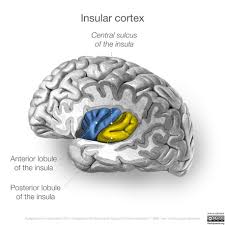“How great is the power of truth! How easily it can defend itself, unaided, against the ingenuity, craftiness and cunning of human beings, and against their lies and plots!”
From “In Defense of Caelius”, by Marcus Tullius Cicero, 106-43 B.C.
In the human brain, the anterior insula processes the emotional component of interoceptive awareness, the anticipation and evaluation of emotional stimuli, and self-awareness.

(The Insular Cortex of the human brain)
Lesions of the insula, or insular cortex are observed in patients with schizophrenia.
Grey matter volume in the insula is decreased in patients with schizophrenia.
Cortical thickness in the insula is reduced in patients with schizophrenia.
In populations at risk for schizophrenia, subjects who go on to develop psychosis have decreased insular grey matter, compared to those who do not become psychotic.
Thus, decreased grey matter in the insula and pathology of the insula drive schizophrenia.
Smartphone addicts have lower gray matter volume in the left anterior insula.
If smartphones decrease grey matter volume in the anterior insula, and grey matter volume in the insula is decreased in patients with schizophrenia, then smartphones drive schizophrenia.

(Girls on smartphones)
Smartphones drive schizophrenia. That’s why the 45.6% increase in the schizophrenia in urban China from 2000 to 2010 was 181% greater, or almost three times greater than its 16.2% increase in rural China.
THE ARTICLES
SEPTEMBER 2010
On September 15, 2010, the journal Schizophrenia Research published “The Role of the Insula in Schizophrenia”, by Korey P. Wylie and Jason R. Tregellas.
The study goes on to say “Involvement of the insular cortex is a common finding in neuroanatomical studies of schizophrenia, yet its contribution to disease pathology remains unknown. This review describes the normal function of the insula and examines pathology of this region in schizophrenia.”
Where “remains unknown” is an example of the propaganda technique known as “stonewalling”.
The study goes on to say “It integrates external sensory input with the limbic system and is integral to the awareness of the body’s state (interoception). Many deficits observed in schizophrenia involve these functions and may relate to insula pathology. Furthermore, reports describing deficits caused by lesions of the insula parallel deficits observed in schizophrenia.”
Thus, lesions of the insula, or insular cortex are observed in patients with schizophrenia.
The study goes on to say “Functionally, the anterior region is specialized for processing the emotional component of interoceptive awareness (Craig 2003, Critchley et al. 2002), the anticipation and evaluation of emotional stimuli (Lovero et al. 2009, Kong et al. 2006), and self-awareness (Craig 2009, Devue et al. 2007).”
Thus, the anterior insula processes the emotional component of interoceptive awareness, the anticipation and evaluation of emotional stimuli, and self-awareness.
The study goes on to say “Based on the anatomical connections and function of the insula, disrupted interoception processing within this region would be expected to disrupt the evaluation of emotional stimuli and boundaries of the self. As described below, these deficits have been widely reported in schizophrenia. Correspondingly, grey matter, cytoarchitectural, functional and protein expression abnormalities are observed in the insula in schizophrenia. It is reasonable to hypothesize, therefore, that many of the functional and behavioral deficits observed in schizophrenia may involve pathology of the insula.”
Thus, pathology of the insula drives schizophrenia.
The study goes on to say “Abnormalities in grey matter volume, cortical thickness, cellular structure, and the expression of proteins within the insula are observed in schizophrenia. Structural imaging techniques using magnetic resonance imaging (MRI) consistently find decreased grey matter in the insula (Honea et al. 2005, Ellison-Wright et al. 2008, Glahn et al. 2008, Fornito et al. 2009, Chan et al. 2009, Kasai et al. 2003, Kim et al. 2003, Takahashi et al. 2004, 2005; Saze et al. 2007, Makris et al. 2006). These deficits are usually bilateral, are present in first-episode schizophrenia, and are progressive in chronic schizophrenia (Ellison-Wright et al. 2008, Chan et al. 2009). It is unclear whether grey matter deficits are localized to a particular subregion of the insula as they have been observed in anterior (Makris et al. 2006), posterior (Saze et al. 2007), or across both areas (Takahashi et al. 2005, Kasai et al. 2003). In monozygotic twins discordant for schizophrenia, the affected twin has decreased grey matter volume in the insula bilaterally (Borgwardt et al. 2009). The bilateral decrease in insular grey matter is present in populations at high risk for developing schizophrenia and progresses further with the transition the psychotic state (Takahashi et al. 2009, Chan et al. 2009). Among the same high-risk population, subjects who go on to develop psychosis have decreased insular grey matter initially compared to those who do not become psychotic (Borgwardt et al. 2007, Takahashi et al. 2009).”
Thus, grey matter volume in the insula is decreased in patients with schizophrenia.
In populations at risk for schizophrenia, subjects who go on to develop psychosis have decreased insular grey matter, compared to those who do not become psychotic.
The study goes on to say “Related to grey matter volume deficits, cortical thickness in the insula also is reduced in schizophrenia. Decreases in the left (Kuperberg et al. 2003), right (Nesvag et al. 2008) or bilateral insula (Roiz-Santianez et al. 2010) are reported. These decreases do not correlate with antipsychotic medication use or clinical measures (Nesvag et al. 2008, Roiz-Santianez 2010).”
Thus, cortical thickness in the insula is reduced in patients with schizophrenia.
FEBRUARY 2020
On February 19, 2020, businessinsider.com said “Smartphone addiction may shrink key areas of your brain in a similar way to drugs”.
Where, with “may shrink”, author Anna Medaris lied bald-facedly and stated that smartphone addiction did not, in fact, shrink key areas of your brain in a similar way to drugs.
Anna walked the specific “insular cortex” back to the general “key areas”.
She also took care not to make any mention of schizophrenia.
That’s an example of the propaganda technique known as “stonewalling”.
Then she shook the doll of “drugs”, and pointed to it, to distract the reader from the sleight-of-hand.
The article goes on to say "Being glued to your iPhone and feeling naked without it is a lot more socially acceptable than experiencing the same pull to cocaine, but new research suggests addiction to both devices and substances have a similarly detrimental effect on key parts of the brain.
The study, out of several universities and research centers in Europe, compared 22 18- to 30-year-olds who met criteria for smartphone addiction to 26 people who did not. Using MRIs, the researchers looked at the size and activity levels of certain brain regions.
They found that those who were considered smartphone addicts had lower gray matter volume — a measure of brain cells — in several areas, including the left anterior insula, which has been ‘robustly associated’ to substance addictions, the researchers write."
Smartphone addicts have lower gray matter volume in the left anterior insula.
Jeff Miller, Honolulu, HI, June 18, 2024
If you’d like to be added to this free mailing list, please send me a note at [email protected].